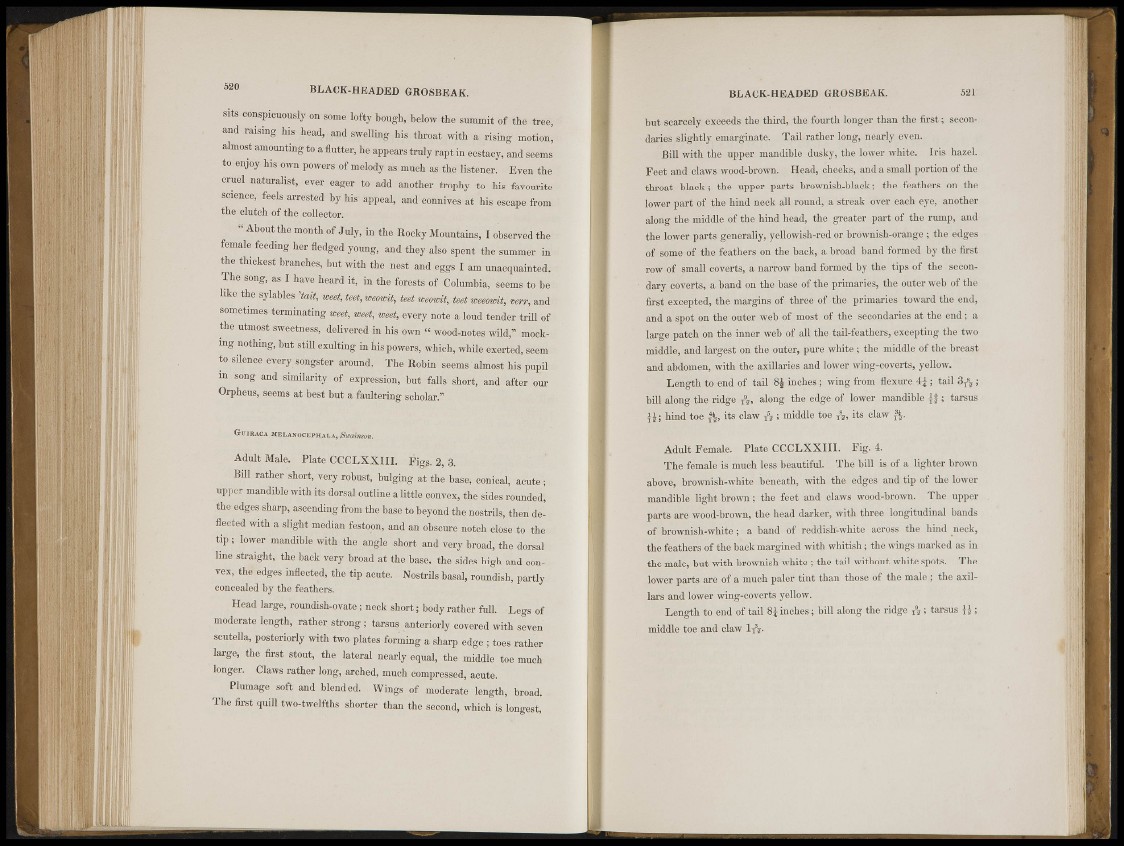
520 BLACK-HEADED GROSBEAK.
sits conspicuously on »me lofty bough, below the summit o^the tree,
and raising his head,.and gelling his throat ,with a, rising motion,
almost amounting to a flutter; ho appears truly rapt in ocstaoy, and seems
to- enjoy, hi« own powers of melody as much as th^f i spht e Even the
cruel naturalist, ever eager ¡ft add another trophy to lus fafomite-'
seu®«V>fo»ls arrested by his Appeal, and connives at 'his escape from
the clutch of the colleetm
; About the ¿»¿th of July, in the Rocky Mo^toins, I obserVid the
female feeding hor fledged young, and thoy also spciiii the summer in
the thickest' b r i e f e s t but with the -nest and eggs I am unacquainted.
The sfehg, as I have heard it, in the "forests of K m b i a y seems to be
like the sylables 'tail, 'weet, teefyi^ffieh% teet peom%teet meotmt, vetr, and
sometimes terminating weet, -weet,'weet, «very note a lottd tender .trill of
tiie utmost sweetness, delivered in his own .« wood-notes wild," mockxng
nothing, bat stUl exulting in tis powers, which, while frateitMi seem
to silence ejvery songster around. The Robin seems almost hil pupil-,
m song and similarity of expression, but falls short, and after our
Orpheus, :seems at best but a fanltoring scholar."
OtriitACX -HKI.ANUCi-. I'HAI.A, ii'C'jitli'Wl.
Adult Male. Plate (.'CCLXXIlli* Figg. 2, 3.
Bill rather short, very robust, bulging, at the base, conical, acute;
uj.per mandiBle-with Bs dorsal outline a, little convex, the siifis rounded,
the^ges sharp, ascending from the base to beyond the nostrils, then deflected
with a slight median festoon, and an obscme not chj f J I4, the
tip ; lower mandible * % the angle short and very broad, the dorsal
line straight, the baek very broad at the.base, the sides high and convex,
thJ'odges inflect«,1, the tip acute. Nostrils: basal,.roundish, partly
concealed 'by the feathers.
Head large, roundish-ovate f l e c k short} body rather full. -Legs ,,f
moderate length, father strong ; tarsus anteriorly covered: with seven
scutellai, posteriorly with two plates, forming a sharp edge -j ftls rather
large* the first stout, the lateral nearly equal, the middle toe much
longer. Claws rather long, arched, much compressed, acute.
Plumage soft and blended. Wings-of moderate length, broad.
The first quill two-twelfths shorter than the second, which is longest,
BLACK-HEADED GROSBEAK. 521
but scarcely exceeds the third, the fourth longer than the first ; secondaries
slightly emarginate. Tail rather long, nearly even.
Bill with the uppüjímandible dusky, the lower white. Iris hazel,
l-'cet and claws wood-brown. Head, cheeks, and a small portion of the
throat black; the upper parts brownish-black; the feathers on the
lower part of the hind neck all round, a streak over each eye, another
a l o n g the middle: Of the hind head, the greater part of the rump, and
the lower parts generally, yellowish-rod or brownish-orange ; the edges
of some of the feathers oh the back, a broad hand formed by the first
row of small coverts, a narrow band formed by the tips of the secondary
coverts, a band oit the base of the primaries, the outer web of the
first excepted, the margins of three of the primaries toward the end,
a i d a spot cin-the outer web of most of the secondaries at the end; a
large patch on the inner web of all the tail-leathers, excepting the two
middle, and largest on the outer, pure white ; the middle of the breast
and abdomeSiiwith the axillaries and lower wing-coverts, yellow.
Length to end of tail 8£ inches ; wing from flexure ; tail ;
bill alohg the ridge along the edge of lower mandible ; tarsus
hind toe its claw A ; middle toe its claw ft.
Adult Female. Plate CÇCLXXIII. Fig. 4.
The female is nmcli less beautiful. The bill is of a lighter brown
above, brownish-white beiekth, with the edges and tip of the lower
mandible light brown ; the feet and claws wood -brown. The upper
parts are wood-brown, the hóail darker, with three 'longitudinal bands
of brownish-white ; a band of reddish-white across the hind neck,
the feathers of the back margined with whitish; the wings marked as in
thé male, but with brownish-white ; the tail without white spots. The
lower parts are of a much paler tint than those of the male ; the axillars
and lower wing-coverts yellow.
Length to «»I of tail 8i incheSf bill along the ridge A ; tarsus ;
middle toe and claw 1